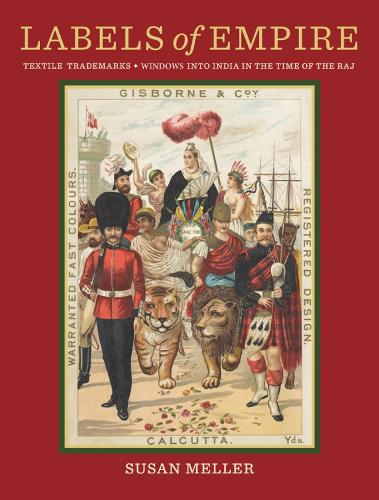
Labels of Empire: Textile Trademarks: Windows into India in the Time of the Raj
(Hardback)
Publishing Details
Labels of Empire: Textile Trademarks: Windows into India in the Time of the Raj
By (Author) Susan Meller
Oro Editions
Oro Editions
19th October 2023
United States
Classifications
General
Non Fiction
746.0954
Physical Properties
Hardback
544
Width 229mm, Height 299mm
3366g
Description
It was said that at one time Great Britain clothed the world. In the 1880s, when the British textile industry was at its most prosperous to date, much of the worlds population wore clothing made from fabric produced in the mills of Lancashire. From 1910 to 1913 alone, seven billion yards of cloth were folded, stamped, labeled, and baled. Most of this output was for exportwith 40 percent of it shipped to India.
To differentiate their goods, British textile manufacturers pasted illustrated paper labels known as shippers tickets to the faceplate of each piece of folded cloth sold into the competitive Indian market. Designed to appeal to the local people, printed and registered in Manchester, these brightly colored images further helped to establish a companys brand. Hindu gods, native animals, scenes from the great Indian epicsthe Mahabharata and Ramayanaand views of everyday life were common subjects. In a sense a form of premium, they provided the consumer with an additional incentive to buy the goods of a particular firm.
With 1,258 color illustrations organized by subject, from Gods and Goddesses to Swaraj and Swadeshi, Labels of Empire begins with the late 19th-century heyday of British textile manufacturing and closes with Indian independence in 1947. By combining visual narrative, magical realism, popular culture, and history in a way never done before, this book gives an unprecedented view of the British textile industry during the time of the Rajand its remarkably successful use of paper labels as trademarks.
Reviews
"What an utter delight these images are. This book so deftly combines beauty, history, commerce, and play. It's so off the main road that everything about it is fresh and surprising. Yet at the same time it is thoroughly accessible." --Malcolm Margolin, founder of Heyday Books
"In Labels of Empire, Meller skillfully pieces together the threads of history using the unassuming medium of cloth labels. The result is a captivating tale of economic competition, cultural influence, and the power of a nation's determination. This outstanding work offers readers a fresh perspective on the Raj era, making it a must-read for history enthusiasts and anyone fascinated by the intersection of culture and commerce." --SELVEDGE Magazine
"Remarkable on many levels, like the India it portrays, Meller's book will probably never be rivalled by a competing text, unlike rug and textile publications. Seldom does one have the opportunity to behold the first truly accessible, yet final, word on any subject; but that is what we have with Labels of Empire." --Tom Cole, HALI Magazine
The excellence and authoritative references of this title cannot be emphasized enough, but it's rare to see such a production promise equal attraction to general-interest audiences. All these strengths make Labels of Empire a unique standout whether libraries are seeking histories, art surveys, or an emphasis on Indian culture.
- D. Donovan, Senior Reviewer, Midwest Book Review
Author Bio
Susan Meller has been collecting and studying textiles for more than 50 years. In the 1960s, she worked in the New York textile industry as a designer and strike-off artist for Riegel Textile Corporation, Dan River Mills, and other fabric converters, traveling to their mills in South Carolina and Georgia to supervise the printing of their fabrics. This early experience gave her an invaluable insight into working operations of what were still, in many respects, 19th-century mills and mill towns. She later founded and created the Design Library (www.design-library.com), formerly in New York City and now located in a converted textile factory in Wappingers Falls, New York. With over 5 million designs, the Design Library is the largest and most extensive commercial archive of period textiles and original textile designs in the world.
Susan Meller is co-author of Textile Designs: Two Hundred Years of European and American Patterns (Abrams, 1991); author of Russian Textiles: Printed Cloth for the Bazaars of Central Asia (Abrams, 2007) and Silk and Cotton: Textiles from the Central Asia that was (Abrams, 2013; La Martinire, 2013); and contributing author to Colors of the Oasis: Central Asian Ikats (The Textile Museum, 2010).
She lives in Berkeley, California with her husband Frank Rubenfeld.
